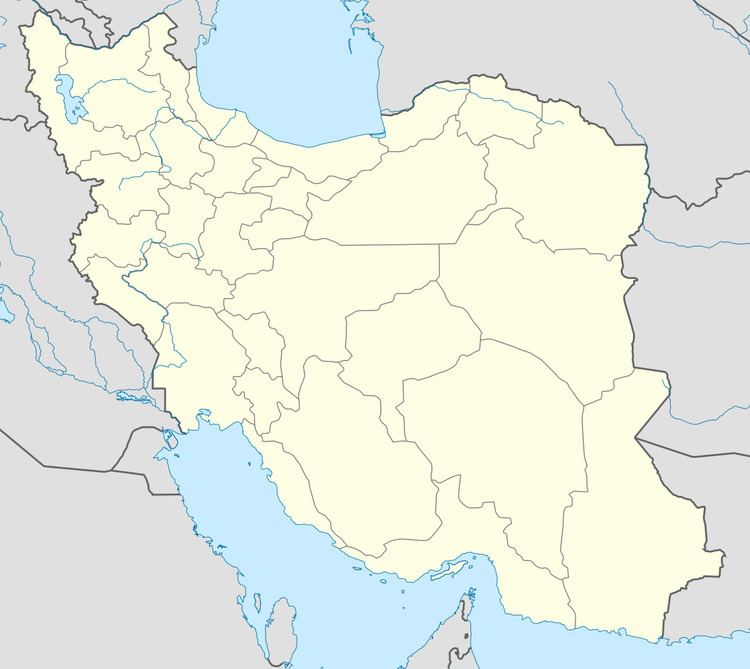Country Iran Bakhsh Kukherd Population 3,144 (2006) Province Hormozgan Province | County Bastak Time zone IRST (UTC+3:30) Local time Saturday 11:51 PM | |
 | ||
Weather 21°C, Wind N at 5 km/h, 61% Humidity | ||
Kukherd (Persian: كوخرد, also Romanized as Kūkherd, Kookherd, and Kuhkhird; also known as Chāleh Kūkherd) is a city in and the capital of Kukherd District, in Bastak County, Hormozgan Province, Iran. At the 2006 census, its population was 3,144, in 637 families.
Contents
- Map of Kookherd Hormozgan Province Iran
- Location and geography
- Demography and ethnicity
- Language
- Agriculture
- Climate
- History and etymology
- Historical sites
- Kukherd in the Cambridge History of Iran
- References
Map of Kookherd, Hormozgan Province, Iran
Kukherd was traditionally part of the region of Larestan. Kukherd's inhabitants are Larestani people. It was a major trading center on the old caravan trading routes between the Persian Gulf and other cities in Iran. It had guest houses, or kārvānsarā, where travelers could rest and recover from the day's journey.
Location and geography
Kukherd is a district (Bakhsh بخش) located on the south western side of Iran in the Hormozgān Province, 155 kilometers south of the city of Lar and 45 kilometers from the city of Bastak. The Mehran river flows through its northern parts. A chain of mountains extends about 55 kilometers from east to west in northern parts of Kukherd forming a natural barrier that separates Koohkerd from other villages. One of the tallest mountains in Kukherd is Nakh (ناخ) rising about 800–900 meters above sea level. This mountain chain also includes the highest peak, the Paletir (پلتير) mountain (1022 meters), and دسكDask (1380 meters) .
Demography and ethnicity
The religion of Kukherd population is the Sunni branch of Islam, most Kukherdis are following the Shafi`i way of فقه Fiqh Sunni. (Persia had a mix of sects and religions but predominantly sunni until the rule of the Safavid dynasty after Shah Ismael who adopted the Shiate as the official religion of their empire.[1] Although the majority of Iranians are Shiites Muslims but Iran is also includes minorities of Sunni Muslims.
Language
The local Kukherd's dialect is known as Larestani لارستاني which spreads in Fars province between the two regions of Larestan and Hormozgan. Laristani is independent of Persian. Nonetheless, Laristanin and these other related languages are closest to Persian by being members of the Southwest Iranian languages. There's a folk belief that this language is one of oldest dialects that have survived from Middle Persian known as Pahlavi Persian. A good number of Kukherd population can speak some Arabic. Others can speak English and Urdu. Many of Kukherdis have migrated to other countries, mainly the UAE, Bahrain and others to pursue better work opportunities.
Agriculture
Kukherd covers wide agricultural lands mainly for wheat, barely and many kinds of vegetables and about 1000 palm tree. Being situated in a dry area, Kukherd suffers shortages of rains and so it was one of the targets in Kukherd authorities to maintain water resources through constructing high water dam projects in order to preserve underground water. Currently there are five dam projects in Kukherd.
north Paltir.
of Paltir
Another tool to preserve water is using a kind of traditional water containers (Berkaبركه ) in local Kukherdi dialect and known as Ab Anbar āb anbār آب انبار, which is a traditional reservoir of drinking water built aboveground in Iran having a structure of a domed shape. Currently, Kukherd still maintain 64 old rain water containers.
Climate
Climate in Kukherd is dry and hot during summer. Summer temperatures vary frequently above 40 °C. It has cold winters and sometimes snow falls on mountains of Nakh. Spring and autumn temperatures are moderate and pleasant.
To deal with the extremely hot summers, many traditional and old houses in Iran have a special mechanism to protect against the heat of summer as they used to build air towers on their homes known as the Windcatcher Bâdgir بادگیر which is an ancient architectural device used for many centuries to create natural ventilation in buildings. The architecture is also spread in many parts of Fars province including Kukherd.
History and etymology
Kukherd civilization goes back to ancient more than 2000 years old. Evidence of the ancient archeology includes some ancient monuments that have been found dating to the Sassanid dynasty approximately that was also discovered in Kukherd. This is in addition to having old tombs and having its unique architecture like the Windcatcher Bâdgir بادگیر Kukherd in Persian consists originally of two old Persian words: “koy كوي” and “kherd”. خرد In the لغت نامه Loghatnaameh Dictionary [2], “koy” means alive and "kherd" means reason which can be translated to "The land of reason". Local historical resources in Kukherd explain that the ancient name of Kukherd was known as Siba after the castle of Siba which was built about 500 BC in the civilization extended from south Arab peninsula to the land of Kukherd. Other resource explain that it goes back to Zoaroster tribe that came all the way from Armenia and settled in Kukherd and built a castle known as Siba.
Historical sites
Among ancient monuments that have been found in Kukherd are:
Kukherd in the Cambridge History of Iran
An early reference to Kukherd is dated to 1649, this is found in the Cambridge History of Iran, Volume 6th:
Went north from Kung through Kuhkird, Bastak and Nimar, where it joined the main route at Lar, From the lesser Ports at Bandar Rig and Bandar Rishahr routes converged near Burazgan and the road to Shiraz Passed through Dalaki, Kazarun and the Dasht_i Arjan, These routes Were subject to extraordinary variations in climatic conditions, scorching heat when only traveling at night was bearable and Perishing cold when travel might be impossible, An English factor, Robert Loftus, noted in April 1628, I stayed in Digerdoo” Dihgirdu” six daies until….
